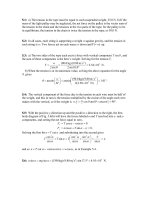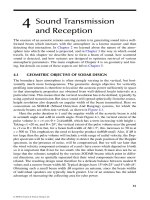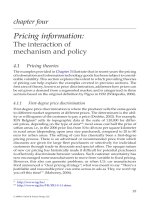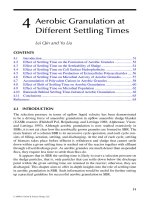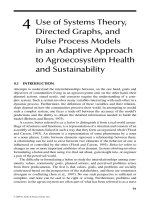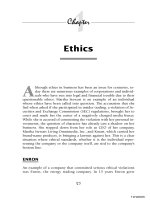Chapter 4 ppt
Bạn đang xem bản rút gọn của tài liệu. Xem và tải ngay bản đầy đủ của tài liệu tại đây (506.35 KB, 55 trang )
© 2008 Pearson Prentice Hall, Electronic Commerce 2008, Efraim Turban, et al.
Chapter 4
Consumer Behavior, Market
Research, and Advertisement
4-2
Learning Objectives
1. Describe the factors that influence
consumer behavior online.
2. Understand the decision-making process
of consumer purchasing online.
3. Describe how companies are building one-
to-one relationships with customers.
4. Explain how personalization is
accomplished online.
5. Discuss the issues of e-loyalty and e-trust
in EC.
6. Describe consumer market research in EC.
4-3
Learning Objectives
7. Describe Internet marketing in B2B, including
organizational buyer behavior.
8. Describe the objectives of Web advertising and its
characteristics.
9. Describe the major advertising methods used on
the Web.
10.Describe various online advertising strategies and
types of promotions.
11. Describe permission marketing, ad management,
localization, and other advertising-related issues.
12.Understand the role of intelligent agents in
consumer issues and advertising applications.
4-4
Learning about
Consumer Behavior Online
A Model of Consumer Behavior Online
Independent (or uncontrollable) variables can be
categorized as personal characteristics and
environmental characteristics
Intervening (or moderating) variables are variables
within the vendors’ control. They are divided into
market stimuli and EC systems
The decision-making process is influenced by the
independent and intervening variables. This
process ends with the buyers’ decisions resulting
from the decision-making process
The dependent variables describe types of
decisions made by buyers
4-5
Learning about
Consumer Behavior Online
4-6
Learning about
Consumer Behavior Online
The independent variables
Personal characteristics
Environmental variables
Social variables
Cultural/community variables
Other environmental variables
The intervening (moderating) variables
The dependent variables: the buying decisions
4-7
The Consumer
Decision-Making Process
Roles people play in
the decision-making
process
Initiator
Influencer
Decider
Buyer
User
A Generic Purchasing-
Decision Model
1. Need identification
2. Information search
3. Evaluation of
alternatives,
4. Purchase and delivery
5. Post-purchase behavior
4-8
The Consumer
Decision-Making Process
A Customer Decision Model in Web Purchasing
Can be supported by both Consumer Decision
Support System (CDSS) facilities and Internet and
Web facilities
4-9
Mass Marketing, Market Segmentation,
and One-to-One Marketing
one-to-one marketing
Marketing that treats each customer in a
unique way
Mass Marketing
Marketing efforts traditionally were targeted to
everyone
Targeted marketing—marketing and advertising
efforts targeted to groups (market segmentation) or
to individuals (one-to-one)—is a better approach
4-10
Mass Marketing, Market Segmentation,
and One-to-One Marketing
market segmentation
The process of dividing a consumer market into
logical groups for conducting marketing research
and analyzing personal information
4-11
Mass Marketing, Market Segmentation,
and One-to-One Marketing
4-12
Mass Marketing, Market Segmentation,
and One-to-One Marketing
4-13
Personalization, Loyalty,
Trust, and Satisfaction in EC
personalization
The matching of services, products, and
advertising content with individual
consumers and their preferences
The major strategies used to compile user
profiles include the following:
Solicit information directly from the user
Observe what people are doing online
Build from previous purchase patterns
Make inferences
4-14
Personalization, Loyalty,
Trust, and Satisfaction in EC
user profile
The requirements, preferences, behaviors,
and demographic traits of a particular
customer
cookie
A data file that is placed on a user’s hard
drive by a remote Web server, frequently
without disclosure or the user’s consent, that
collects information about the user’s
activities at a site
4-15
Personalization, Loyalty,
Trust, and Satisfaction in EC
Customer Loyalty
e-loyalty
Customer loyalty to an e-tailer or loyalty programs
delivered online or supported electronically
4-16
Personalization, Loyalty,
Trust, and Satisfaction in EC
4-17
Personalization, Loyalty,
Trust, and Satisfaction in EC
trust
The psychological status of willingness to depend
on another person or organization
How to increase trust in EC
Affiliate with an objective third party
Establish trustworthiness
4-18
Personalization, Loyalty,
Trust, and Satisfaction in EC
4-19
Market Research for EC
Methods for Conducting Market Research Online
Market research that uses the Internet frequently is
faster and more efficient and allows the researcher
to access a more geographically diverse audience
Web market researchers can conduct a very large
study much more cheaply than with other methods
4-20
Market Research for EC
What are marketers looking for in EC market
research?
What are the purchase patterns for individuals
and groups (market segmentation)?
What factors encourage online purchasing?
How can we identify those who are real buyers
from those who are just browsing?
How does an individual navigate—does the
consumer check information first or do they go
directly to ordering?
What is the optimal Web page design?
4-21
Market Research for EC
4-22
Market Research for EC
Market research for one-to-one approaches
Direct solicitation of information (surveys, focus
groups)
Observing what customers are doing on the Web
Collaborative filtering
4-23
Market Research for EC
4-24
Market Research for EC
Observing Customers
transaction log
A record of user activities at a company’s Web site
clickstream behavior
Customer movements on the Internet
Web bugs
Tiny graphics files embedded in e-mail messages and in
Web sites that transmit information about users and their
movements to a Web server
spyware
Software that gathers user information over an Internet
connection without the user’s knowledge
4-25
Market Research for EC
clickstream data
Data that occur inside the Web environment; they
provide a trail of the user’s activities (the user’s
clickstream behavior) in the Web site
clickstream data
Data that occur inside the Web environment; they
provide a trail of the user’s activities (the user’s
clickstream behavior) in the Web site
